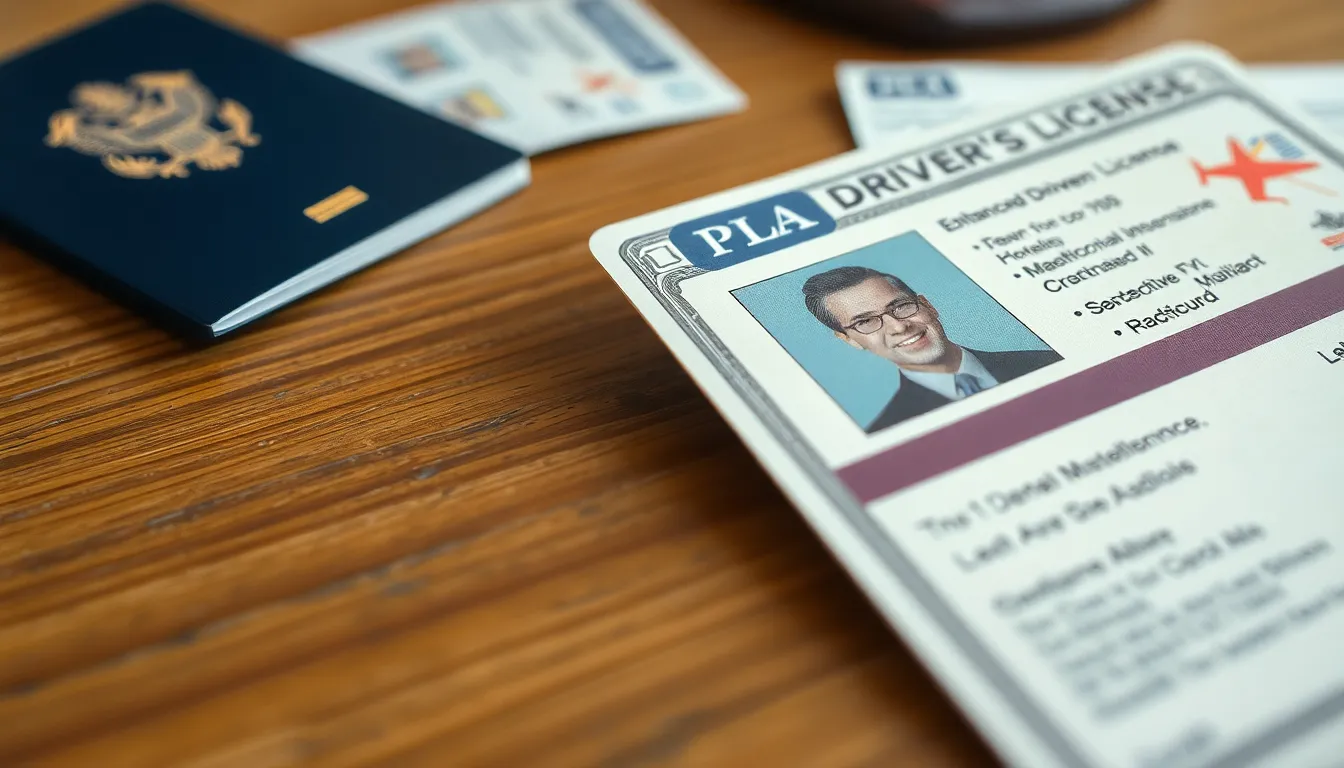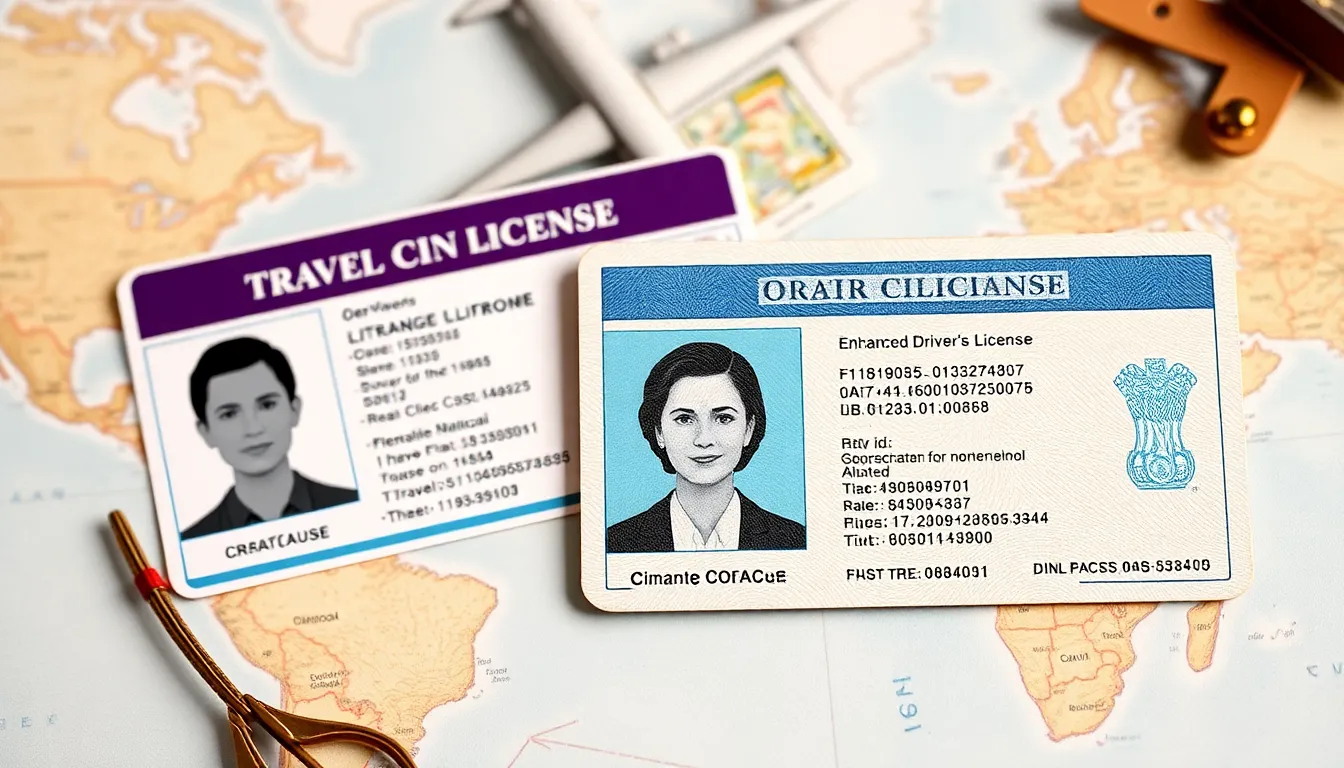In a world where identification can feel like a game of hide and seek, understanding the difference between a Real ID and an Enhanced Driver’s License is crucial. Picture this: you’re at the airport, and you whip out your driver’s license only to be met with a raised eyebrow from security. Spoiler alert: not all licenses are created equal.
The Real ID is like the VIP pass to travel, while the Enhanced Driver’s License offers a little extra flair for those border-crossing adventures. So, which one should you choose? Buckle up as we dive into the nitty-gritty of these two IDs, helping you navigate your way through the bureaucratic maze with confidence and maybe even a chuckle or two. After all, who knew ID shopping could be this entertaining?
Table of Contents
ToggleOverview of Real ID and Enhanced Driver’s License
Real ID serves as a federally compliant identification, needed for domestic air travel and entry into secure facilities. It’s available in all states and ensures that individuals meet specific security standards mandated by the federal government. When obtaining a Real ID, applicants must provide proof of identity, residency, and lawful status in the U.S.
Enhanced Driver’s License, on the other hand, offers additional benefits. It not only serves as a regular driver’s license but also provides an easier way to cross international borders to Canada and Mexico. This type of license includes features such as a special design that denotes its enhanced capabilities.
Differences exist between the two forms of identification. While both serve as valid proof of identity, only a Real ID satisfies federal requirements for air travel. In contrast, an Enhanced Driver’s License emphasizes border crossing.
Requirements differ based on the type of license sought. Real ID applicants must present a Social Security number, proof of identity, and documentation showing residency. Enhanced Driver’s License seekers will also need to present these documents, together with additional proof of citizenship.
Overall, understanding these distinctions aids in making informed choices when selecting between Real ID and an Enhanced Driver’s License. Both licenses serve essential functions, but the appropriate choice hinges on individual travel needs and preferences.
Key Differences Between Real ID and Enhanced Driver’s License


Understanding the distinctions between the Real ID and Enhanced Driver’s License aids in navigating travel requirements effectively. Each identification type offers unique features tailored to different needs.
Purpose and Functionality
Real IDs serve as federally compliant identification documents. They’re mandatory for passengers flying domestically and accessing federal facilities. An Enhanced Driver’s License, on the other hand, operates as a standard driver’s license but includes additional features. It allows individuals to cross borders into Canada and Mexico without a passport. Enhanced licenses simplify international travel, making them suitable for frequent cross-border travelers. Both types fulfill crucial roles, but target different aspects of identification.
Identification and Travel
For air travel, Real IDs fulfill federal identification requirements. Without one, travelers face restrictions at TSA checkpoints. In contrast, Enhanced Driver’s Licenses excel in situations involving land and sea border crossings. They allow entry into neighboring countries without a passport, which can be advantageous for road trips. While both licenses confirm identity, only a Real ID is valid for planes. Understanding these travel nuances is vital for choosing the appropriate identification for specific journeys.
Benefits of Real ID
Real ID offers multiple advantages, particularly for those traveling within the United States. Understanding its benefits enhances decision-making for identification needs.
Federal Compliance
Real ID complies with federal regulations established by the Secure and Fair Enforcement for Mortgage Licensing Act. Meeting these standards ensures that a Real ID can be used for boarding domestic flights and entering federal facilities. States must adhere to specific documentation requirements, such as proof of identity and residency. Only individuals who provide adequate documentation receive a Real ID, guaranteeing its integrity as an accepted form of identification. Travelers who present a Real ID typically experience smoother security processes at airports, reducing the potential for delays.
Security Features
Real IDs incorporate advanced security features to prevent counterfeiting and identity theft. These features include holograms, barcodes, and other modern technology elements. The design itself distinguishes a Real ID from standard drivers’ licenses, with a star denoting its federal compliance. In addition, these IDs undergo stringent verification processes at the issuance stage. Enhanced security helps protect personal information, making it more secure for users. Travelers often find that having a Real ID aids in minimizing concerns about identification fraud during their journeys.
Benefits of Enhanced Driver’s License
Enhanced Driver’s Licenses offer significant advantages, particularly for those who frequently travel across borders. They serve as an efficient alternative to a passport for U.S. citizens heading to Canada or Mexico.
Convenience for Travel
Enhanced Driver’s Licenses simplify cross-border travel. Valid for entry into Canada and Mexico, they eliminate the need for additional documentation like a passport. Travelers enjoy a faster and smoother process when presenting these licenses at border crossings. Unlike a passport, obtaining an Enhanced Driver’s License often requires less paperwork. Many find this option especially convenient for spontaneous trips or weekend getaways.
State Compliance and Usage
Enhanced Driver’s Licenses comply with state regulations while fulfilling federal requirements. Each state issues them, ensuring they meet specific security standards. They serve as valid identification for various situations, including voting and accessing government services. Enhanced Driver’s Licenses also maintain their status as primary identification for drivers, providing a seamless experience for daily use. Consequently, they offer a dual purpose—acting as both a driver’s license and an accepted form of travel ID.
Choosing between a Real ID and an Enhanced Driver’s License hinges on individual travel needs. For those planning to fly domestically a Real ID is essential while the Enhanced Driver’s License offers convenience for border crossings into Canada and Mexico. Understanding the specific requirements and benefits of each option can lead to informed decisions.
Travelers should consider their typical journeys and the identification they’ll require. With the right choice in hand navigating air travel or crossing borders becomes a smoother experience. Both forms of identification serve vital roles in ensuring compliance with federal regulations while providing peace of mind for travelers.



